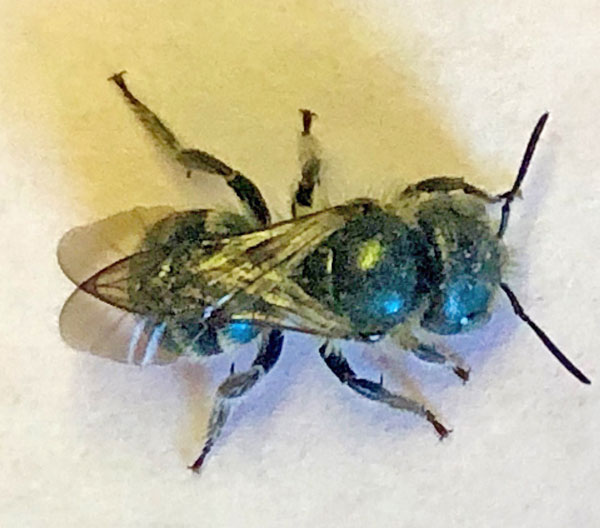As the days get warmer, fresh green shoots appear, letting us know that our gardens are beginning to come alive and so are the insects.
One of these is the “mason bee”, a native, solitary bee. Mason bees (Osmia lignaria) are one of the 400 native, solitary bees in Minnesota. Mason bees are smaller than honey bees and are sometimes called blue orchard bees because of their metallic bluish coloring. They are stem-nesting bees and they use mud to seal their nesting tubes, thus the name “mason” bees.
They are only active in the spring so each year their appearance depends on the weather. When the temperature is 50+degrees consistently for a couple of days, the mason bee will awaken and in the central Minnesota area March and early April are typically when this occurs. 
The fully formed adult bee emerges and male bees are the first to make an appearance. After searching out a source of nectar for energy, they will wait for a female bee with which to mate, this is their sole purpose, with a life span of only 2-3 weeks. After a female bee becomes impregnated, she will then search for a nesting site, begin to gather nectar, pollen and mud and lay her eggs. The female lifespan is about 4-6 weeks. Once she locates a suitable site she will mark it with her scent and immediately begin to create the nesting chambers for her eggs. The nesting chamber consists of protective mud partitions, a pollen loaf and a single egg. The female uses her mandibles (mouth parts) to gather this mud and proceeds to lay female eggs at the back of the stem tube and males at the front separating each with a division of mud. She will then create a thicker mud cap at the end of her nesting tube, sealing it to protect her eggs. Inside the stem tube the eggs will hatch; the larva eats the pollen loaf and then spins a cocoon. This cocoon will allow them to hibernate in the winter months. This cycle will take place only once each season. Once a female lays her eggs, she will die.
What makes them so desirable?
- Mason bees are native bees and are acclimated to our climate patterns.
- They fly in lower temperatures and thus are active when our fruit trees and berry producing shrubs need pollination to be fertilized.
- They are generalists, which means that they love all kinds of flowers.
- They are ‘messy’ and instead of storing pollen only on their legs, they belly flop onto flowers. Their abdomen hairs will hold this pollen and when it travels from blossom to blossom, this dry pollen is spread, aiding in cross pollination, important for fruit bearing trees and shrubs.
- They are much more efficient than honey bees at pollination. Honey bees are social bees. They must feed a large population of developing bees in the hive. To do this they need to fly long distances (up to 5 miles) to gather nectar and pollen. Mason bees only need to gather pollen and nectar for 25 eggs during their lifetime. They forage within a 300 ft. radius of their nests.
- They are docile bees and do not sting.
What can we do to attract them to our yards?
- Provide fruit trees and berry producing shrubs.
- Plant a variety of flowers, native cultivars are best.
- Choose flowers that offer a succession of blooms. Early spring is especially important for mason bees but offering a variety of flowers through fall will provide nutrition for all pollinators.
- Leave some bare un-mulched soil; they need a source of mud for their nesting chambers.
- Purchase plants from a reputable source offering plants that have not been treated with neonicotinoids.
- Eliminate the use of pesticides that are dangerous to pollinators, look for the new warning symbol on product labels.
- Provide nesting habitat. In the fall, leave your woody stems standing. Since they are stem-nesting bees, hollow stems such as day lilies, joe pye weed, and monarda are ideal. In the spring don’t cut your stems back. New growth will hide the dried stems.
- Put up a mason bee house facing the morning sun (east-south east).
 Hang it about 5-7 ft. from the ground on a sturdy wall or fence. Make sure it is within 100-300 ft. from a pollen/nectar source.
Hang it about 5-7 ft. from the ground on a sturdy wall or fence. Make sure it is within 100-300 ft. from a pollen/nectar source.
Spring is filled with promises of things to come. I’m eagerly anticipating the arrival of my mason bee cocoons. My mason bee house will be waiting to host these little “muddy buddies”.
For more information about these and other native bees check out these sites:
- State of Minnesota: Native bees
- University of Minnesota Bee Lab: Bee Diversity
- The Honey Bee Conservancy
- Buzzworthy
- DIY mason bee house
- National Wildlife Federation
By Val McGruder, Hennepin County Master Gardener
Photos by Val McGruder




